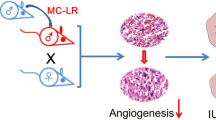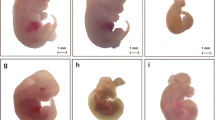Abstract
The aim of this study was to explore the direct embryonic teratogenicity of vinyl chloride monomer (VCM), especially the toxic effects on the early development of the nervous system and its underlying mechanisms. Pregnant mice at embryonic day 6.5 (E6.5) were injected with different doses of VCM (200, 400 and 600 mg/kg) and embryos were harvested at E10.5. Our results showed that doses higher than 400 mg/kg of VCM increased the incidence of malformed embryos, especially the neural tube defects (NTDs). In addition, high-dose of VCM decreased mitotic figure counts in the neuroepithelium and enhanced the percentage of cells in G0/G1 phase, while they were reduced in S phase. The more VCM was injected into mice, the fewer positive PCNA cells were seen and the more positive TUNEL cells were observed in the neuroepithelium. Moreover, significant increases in the levels of caspase-3 protein were observed in NTD embryos. Our results demonstrate that during early pregnancy, exposure to doses higher than 400 mg/kg of VCM increases the incidence of malformations and particularly the rate of NTDs. High-dose of VCM inhibits the proliferation of neural cells and induces cell apoptosis, leading to an imbalance in the ratio of proliferation and apoptosis. Meanwhile, the apoptosis of neuroepithelial cells might be accelerated by the activation of the caspase-3 pathway, and it might be a reason for NTDs.






Similar content being viewed by others
References
Bergman K (1982) Reactions of vinyl chloride with RNA and DNA of various mouse tissues in vivo. Arch Toxicol 49(2):117–129
Bergman K (1983) Interactions of trichloroethylene with DNA in vitro and with RNA and DNA of various mouse tissues in vivo. Arch Toxicol 54(3):181–193
Cao Y, Zhao Z, Eckert RL, Reece EA (2011) Protein kinase Cbeta2 inhibition reduces hyperglycemia-induced neural tube defects through suppression of a caspase 8-triggered apoptotic pathway. Am J Obst Gynecol 204(3):226, e221–e225. doi:10.1016/j.ajog.2011.01.013
Chappell JH Jr, Wang XD, Loeken MR (2009) Diabetes and apoptosis: neural crest cells and neural tube. Apoptosis Int J Program Cell Death 14(12):1472–1483. doi:10.1007/s10495-009-0338-6
Copp AJ, Greene ND (2010) Genetics and development of neural tube defects. J Pathol 220(2):217–230. doi:10.1002/path.2643
Dahlstrand J, Lardelli M, Lendahl U (1995) Nestin mRNA expression correlates with the central nervous system progenitor cell state in many, but not all, regions of developing central nervous system. Brain Res Dev Brain Res 84(1):109–129
D’Amelio M, Sheng M, Cecconi F (2012) Caspase-3 in the central nervous system: beyond apoptosis. Trends Neurosci 35(11):700–709. doi:10.1016/j.tins.2012.06.004
Delgado ME, Olsson M, Lincoln FA, Zhivotovsky B, Rehm M (2013) Determining the contributions of caspase-2, caspase-8 and effector caspases to intracellular VDVADase activities during apoptosis initiation and execution. Biochim Biophys Acta 1833(10):2279–2292. doi:10.1016/j.bbamcr.2013.05.025
Dennery PA (2007) Effects of oxidative stress on embryonic development. Birth Defects Res C 81(3):155–162. doi:10.1002/bdrc.20098
Dietrich DR (1993) Toxicological and pathological applications of proliferating cell nuclear antigen (PCNA), a novel endogenous marker for cell proliferation. Crit Rev Toxicol 23(1):77–109. doi:10.3109/10408449309104075
Dogliotti E (2006) Molecular mechanisms of carcinogenesis by vinyl chloride. Annali dell’Istituto superiore di sanita 42(2):163–169
Elledge RM, Lee WH (1995) Life and death by p53. BioEssays 17(11):923–930. doi:10.1002/bies.950171105
Ernst C, Christie BR (2006) The putative neural stem cell marker, nestin, is expressed in heterogeneous cell types in the adult rat neocortex. Neuroscience 138(1):183–188. doi:10.1016/j.neuroscience.2005.10.065
Fox AJ, Collier PF (1977) Mortality experience of workers exposed to vinyl chloride monomer in the manufacture of polyvinyl chloride in Great Britain. Br J Ind Med 34(1):1–10
Gavrieli Y, Sherman Y, Ben-Sasson SA (1992) Identification of programmed cell death in situ via specific labeling of nuclear DNA fragmentation. J Cell Biol 119(3):493–501
Guillouf C, Rosselli F, Krishnaraju K, Moustacchi E, Hoffman B, Liebermann DA (1995) p53 involvement in control of G2 exit of the cell cycle: role in DNA damage-induced apoptosis. Oncogene 10(11):2263–2270
Harris MJ, Juriloff DM (1999) Mini-review: toward understanding mechanisms of genetic neural tube defects in mice. Teratology 60(5):292–305. doi:10.1002/(SICI)1096-9926(199911)60:5<292:AID-TERA10>3.0.CO;2-6
Hathway DE (1977) Comparative mammalian metabolism of vinyl chloride and vinylidene chloride in relation to oncogenic potential. Environ Health Perspect 21:55–59
Hewitson TD, Bisucci T, Darby IA (2006) Histochemical localization of apoptosis with in situ labeling of fragmented DNA. Methods Mol Biol 326:227–234. doi:10.1385/1-59745-007-3:227
Hollstein M, Marion MJ, Lehman T, Welsh J, Harris CC, Martel-Planche G, Kusters I, Montesano R (1994) p53 mutations at A:T base pairs in angiosarcomas of vinyl chloride-exposed factory workers. Carcinogenesis 15(1):1–3
Infante PF, Wagoner JK, Waxweiler RJ (1976) Carcinogenic, mutagenic and teratogenic risks associated with vinyl chloride. Mutat Res 41(1 spel. no):131–141
John JA, Smith FA, Schwetz BA (1981) Vinyl chloride: inhalation teratology study in mice, rats and rabbits. Environ Health Perspect 41:171–177
Kibar Z, Capra V, Gros P (2007) Toward understanding the genetic basis of neural tube defects. Clin Genet 71(4):295–310. doi:10.1111/j.1399-0004.2007.00793.x
Kim TH, Goodman J, Anderson KV, Niswander L (2007) Phactr4 regulates neural tube and optic fissure closure by controlling PP1-, Rb-, and E2F1-regulated cell-cycle progression. Dev Cell 13(1):87–102. doi:10.1016/j.devcel.2007.04.018
Li Y, Long C, Lin G, Marion MJ, Freyer G, Santella RM, Brandt-Rauf PW (2009) Effect of the XRCC1 codon 399 polymorphism on the repair of vinyl chloride metabolite-induced DNA damage. J Carcinog 8:14. doi:10.4103/1477-3163.56290
Mitchell LE (2005) Epidemiology of neural tube defects. Am J Med Genet C 135C(1):88–94. doi:10.1002/ajmg.c.30057
Mocci F, Nettuno M (2006) Plasma mutant-p53 protein and anti-p53 antibody as a marker: an experience in vinyl chloride workers in Italy. J Occup Environ Med 48(2):158–164. doi:10.1097/01.jom.0000183097.72738.a7
Moldovan GL, Pfander B, Jentsch S (2007) PCNA, the maestro of the replication fork. Cell 129(4):665–679. doi:10.1016/j.cell.2007.05.003
Muskhelishvili L, Latendresse JR, Kodell RL, Henderson EB (2003) Evaluation of cell proliferation in rat tissues with BrdU, PCNA, Ki-67(MIB-5) immunohistochemistry and in situ hybridization for histone mRNA. J Histochem Cytochem 51(12):1681–1688
Quemelo PR, Lourenco CM, Peres LC (2007) Teratogenic effect of retinoic acid in swiss mice. Acta cirurgica brasileira/Sociedade Brasileira para Desenvolvimento Pesquisa em Cirurgia 22(6):451–456
Reece EA, Ma XD, Zhao Z, Wu YK, Dhanasekaran D (2005) Aberrant patterns of cellular communication in diabetes-induced embryopathy in rats: II, apoptotic pathways. Am J Obstet Gynecol 192(3):967–972. doi:10.1016/j.ajog.2004.10.592
Roy TS, Andrews JE, Seidler FJ, Slotkin TA (1998) Nicotine evokes cell death in embryonic rat brain during neurulation. J Pharmacol Exp Therap 287(3):1136–1144
Sadler TW (2005) Embryology of neural tube development. Am J Med Genet C 135C(1):2–8. doi:10.1002/ajmg.c.30049
Schindler J, Li Y, Marion MJ, Paroly A, Brandt-Rauf PW (2007) The effect of genetic polymorphisms in the vinyl chloride metabolic pathway on mutagenic risk. J Hum Genet 52(5):448–455. doi:10.1007/s10038-007-0134-5
Shalat SL, Walker DB, Finnell RH (1996) Role of arsenic as a reproductive toxin with particular attention to neural tube defects. J Toxicol Environ Health 48(3):253–272. doi:10.1080/009841096161320
Shizukuda Y, Reyland ME, Buttrick PM (2002) Protein kinase C-delta modulates apoptosis induced by hyperglycemia in adult ventricular myocytes. Am J Physiol Heart Circ Physiol 282(5):H1625–H1634. doi:10.1152/ajpheart.00783.2001
Storer RD, Jackson NM, Conolly RB (1984) In vivo genotoxicity and acute hepatotoxicity of 1,2-dichloroethane in mice: comparison of oral, intraperitoneal, and inhalation routes of exposure. Cancer Res 44(10):4267–4271
Suarez L, Felkner M, Brender JD, Canfield M, Hendricks K (2008) Maternal exposures to cigarette smoke, alcohol, and street drugs and neural tube defect occurrence in offspring. Matern Child Health J 12(3):394–401. doi:10.1007/s10995-007-0251-y
Swenberg JA, Ham A, Koc H, Morinello E, Ranasinghe A, Tretyakova N, Upton PB, Wu K (2000) DNA adducts: effects of low exposure to ethylene oxide, vinyl chloride and butadiene. Mutat Res 464(1):77–86
Thornton SR, Schroeder RE, Robison RL, Rodwell DE, Penney DA, Nitschke KD, Sherman WK (2002) Embryo-fetal developmental and reproductive toxicology of vinyl chloride in rats. Toxicol Sci 68(1):207–219
Tomanek M, Chronowska E (2006) Immunohistochemical localization of proliferating cell nuclear antigen (PCNA) in the pig ovary. Folia histochemica et cytobiologica 44(4):269–274
Wang Y, Prives C (1995) Increased and altered DNA binding of human p53 by S and G2/M but not G1 cyclin-dependent kinases. Nature 376(6535):88–91. doi:10.1038/376088a0
Wang XX, Xiao JW, Meng HL, Cui T, Niu KL, Li B (2010) [Effect of vinyl chloride on reproductive and endocrine system of male rats]. Zhonghua lao dong wei sheng zhi ye bing za zhi = Zhonghua laodong weisheng zhiyebing zazhi = Chin J Ind Hyg Occup Dis 28(7):517–520
Wei X, Li H, Miao J, Zhou F, Liu B, Wu D, Li S, Wang L, Fan Y, Wang W, Yuan Z (2012) Disturbed apoptosis and cell proliferation in developing neuroepithelium of lumbo-sacral neural tubes in retinoic acid-induced spina bifida aperta in rat. Int J Dev Neurosci 30(5):375–381. doi:10.1016/j.ijdevneu.2012.03.340
Zhao SF, Zhang XC, Zhang LF, Zhou SS, Zhang F, Wang QF, Wang YL, Bao YS (1997) The evaluation of developmental toxicity of chemicals exposed occupationally using whole embryo culture. Int J Dev Biol 41(2):275–282
Zhao Z, Yang P, Eckert RL, Reece EA (2009) Caspase-8: a key role in the pathogenesis of diabetic embryopathy. Birth Defects Res B 86(1):72–77. doi:10.1002/bdrb.20185
Zhao Z, Eckert RL, Reece EA (2012) Reduction in embryonic malformations and alleviation of endoplasmic reticulum stress by nitric oxide synthase inhibition in diabetic embryopathy. Reproductive Sci 19(8):823–831. doi:10.1177/1933719111434543
Zhu SM, Xia ZL, Wang AH, Ren XF, Jiao J, Zhao NQ, Qian J, Jin L, Christiani DC (2008) Polymorphisms and haplotypes of DNA repair and xenobiotic metabolism genes and risk of DNA damage in Chinese vinyl chloride monomer (VCM)-exposed workers. Toxicol Lett 178(2):88–94. doi:10.1016/j.toxlet.2008.02.009
Acknowledgments
This study was supported by grants from the National Natural Science Foundation of China (31271467), Natural Science Foundation Project of CQ CSTC (2010BB5031), and The Innovation Foundation of the Third Military Medical University, China (2011XHG01).
Conflict of interest
We declare that we have no conflict of interest.
Author information
Authors and Affiliations
Corresponding author
Electronic supplementary material
Below is the link to the electronic supplementary material.
Rights and permissions
About this article
Cite this article
Quan, H., Ma, T., Zhao, X. et al. Vinyl Chloride Monomer (VCM) Induces High Occurrence of Neural Tube Defects in Embryonic Mouse Brain During Neurulation. Cell Mol Neurobiol 34, 619–630 (2014). https://doi.org/10.1007/s10571-014-0049-6
Received:
Accepted:
Published:
Issue Date:
DOI: https://doi.org/10.1007/s10571-014-0049-6




